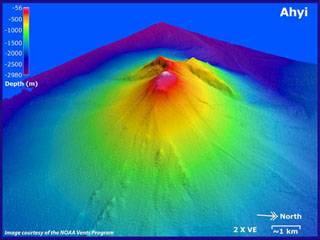Report on Ahyi (United States) — September 1985
Scientific Event Alert Network Bulletin, vol. 10, no. 9 (September 1985)
Managing Editor: Lindsay McClelland.
Ahyi (United States) Discolored water but no eruption plume
Please cite this report as:
Global Volcanism Program, 1985. Report on Ahyi (United States) (McClelland, L., ed.). Scientific Event Alert Network Bulletin, 10:9. Smithsonian Institution. https://doi.org/10.5479/si.GVP.SEAN198509-284141
Ahyi
United States
20.42°N, 145.03°E; summit elev. -75 m
All times are local (unless otherwise noted)
On 2 September, a Continental Air Micronesia pilot observed a zone of brown and light green discolored water about 3 km in diameter, centered about 30 km S of Farallon de Pajaros. No eruption plume was seen by the pilot and inspection of satellite images for several days after 2 September revealed no visible plumes. Cloudy weather obscured the area in the days immediately preceding 2 September. No other reports of activity have been received.
The location of the 1985 activity is approximate, but is not inconsistent with the position of the 1969 eruption and the seamount.
[Report reviewed and attributed to Ahyi in 2023.]
Geological Summary. Ahyi seamount is a large conical submarine volcano that rises to within 75 m of the ocean surface ~18 km SE of the island of Farallon de Pajaros in the northern Marianas. Water discoloration has been observed there, and in 1979 the crew of a fishing boat felt shocks over the summit area, followed by upwelling of sulfur-bearing water. On 24-25 April 2001 an explosive eruption was detected seismically by a station on Rangiroa Atoll, Tuamotu Archipelago. The event was well constrained (+/- 15 km) at a location near the southern base of Ahyi. An eruption in April-May 2014 was detected by NOAA divers, hydroacoustic sensors, and seismic stations.
Information Contacts: N. Banks, CVO, Vancouver, WA; W. Gould, NOAA/NESDIS.

